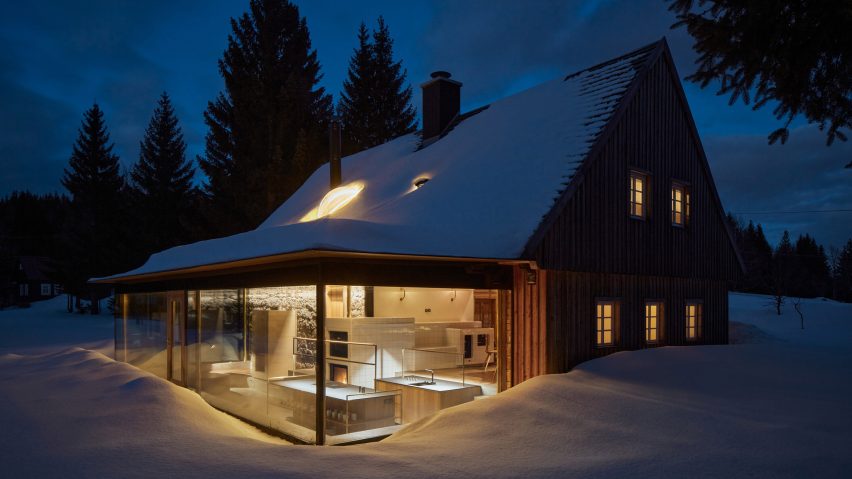Mjölk Architekti has renovated a 130-year-old dwelling in the north of the Czech Republic, adding a glass extension, sunken living area and domed skylight.
Czech architecture studio Mjölk Architekti left one side of the cottage, which is situated in a meadow near the Jizera Mountains, in its original state to increase the visual impact of the new elements.
The studio preserved the cottage's original 19th-century timber and granite structure as well as its thatched roof and contrasted these by installing an extension with floor-to-ceiling glass walls and a flat roof. This levels off at a 90-degree angle from the steeply pitched existing roof.
"We've complemented [the existing cabin] with a new quality that doesn't seek to compete with the past," said Mjölk Architekti. "Behind the curtain of the original cabin, a glittering glass extension has sprung up."
This sense of contrast continues throughout the interior, in which the designers aimed to use modern and playful finishes alongside traditional materials and furnishings.
"We didn't want to forcefully place pieces of global design into the house," said the studio. "The new pieces are complemented with old furniture lovingly selected by the clients themselves."
One of the most dramatic additions is in the extension's living space, which features a ceiling clad in glossy bronze sheets.
Reflections in the ceiling give the space an increased sense of height and echo the playfulness of the sunken living area below. This is surrounded by a ledge with built-in bench seating.
The reconfigured layout of the ground floor revolves around a large volume, clad in glossy white tiles, that contains an oven and stove.
This unites the kitchen, which is characterised by its sleek fittings and concrete surround, with the dining space that has dark timber walls, floor, ceiling and furniture.
A domed skylight illuminates the hallway and landing area in the heart of the house, which has been fitted with a contemporary steel staircase.
Where some of the interior walls and floors could not be salvaged during the restoration process, the structure has been reconstructed by inserting plywood panels, as well as glass panels both between beams and on the floor.
The structural history of the house is easily visible in the four bedrooms, which share warm red-painted walls and exposed rafters, one of which doubles as a children's playroom.
The glass walls allow daylight to reach into the first floor from the small windows in the original front and sides of the cottage's facade.
The studio also added an "almost invisible" sauna on the grounds of the cabin, which appears to be sunken into the earth – similarly to the kitchen and living room inside.
"We refurbished the house with the future in mind, but at the same time, we didn't feel like letting go of all the wonderful, wild and unwieldy aspects of its past," summarised the studio.
Other remote cabins featured on Dezeen include a wooden hut in Chile informed by vernacular fishing huts by Guillermo Acuña Arquitectos Asociados and a holiday retreat on an English farm above a track used by sheep by Akin Studio.
The photography is by BoysPlayNice.

